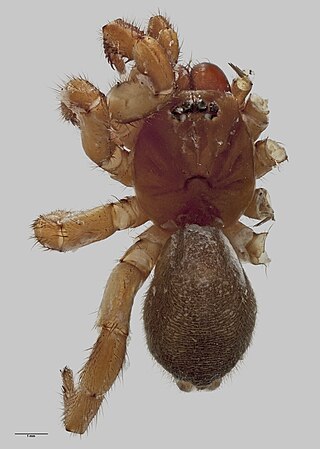Zealanapis australis is a spider species in the genus Zealanapis found in New Zealand.

Desis marina, the intertidal spider, is a spider species found in New Zealand, New Caledonia, and the Chatham Islands.

Gasparia is a genus of South Pacific araneomorph spiders in the family Toxopidae, and was first described by Brian J. Marples in 1956. Originally placed with the intertidal spiders, it was moved to the Toxopidae in 2017.
Syrorisa is a monotypic genus of South Pacific intertidal spiders containing the single species, Syrorisa misella. It was first described by Eugène Simon in 1908, and has only been found on New Caledonia and Australia. Originally placed in the Amaurobiidae, it was moved to the Desidae in 1967.

Algidiella is a monotypic genus of spiders in the family Anapidae. It was first described by Rix and Harvey in 2010. As of 2023, it contains only one species, Algidiella aucklandica.
Cantuaria dunedinensis is a species of trapdoor spider endemic to New Zealand.
Cantuaria insulana is a species of trapdoor spider endemic to New Zealand.
Cantuaria minor is a species of trapdoor spider endemic to New Zealand.
Cantuaria toddae is a species of trapdoor spider endemic to New Zealand.

Stanwellia hapua is a species of Mygalomorph spider endemic to New Zealand.
Stanwellia kaituna is a species of Mygalomorph spider endemic to New Zealand.
Stanwellia puna is a species of Mygalomorph spider endemic to New Zealand.

Stanwellia regia is a species of Mygalomorph spider endemic to New Zealand.

Stanwellia taranga is a species of Mygalomorph spider endemic to New Zealand.
Migas australis is a species of Mygalomorph spider endemic to New Zealand.

Migas insularis is a species of Mygalomorph spider endemic to New Zealand.

Australomimetus mendicus is a species of Mimetidae that is endemic to New Zealand.
Paradictyna ilamia is a species of Dictynidae spider that is endemic to New Zealand.
Viridictyna kikkawai is a species of Dictynidae spider that is endemic to New Zealand.

Viridictyna parva is a species of Dictynidae spider that is endemic to New Zealand.










